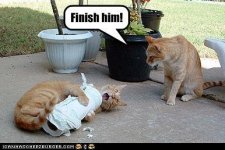FFChineseman
Member
- Joined
- Jul 21, 2009
- Messages
- 102
As the subject, I was fishing in a local stocked creek. No luck on nymph, streamer, or dry fly, but caught three rainbow on a black wolly buggeer.
my question is how long it takes to have the stocked fish realized there are different source of food such as flies and nymphes. They seem only take wolly bugger which i believe they might think that is a minnow. maybe i will have more luck on other kinds of flies when they are in the water longer?
my question is how long it takes to have the stocked fish realized there are different source of food such as flies and nymphes. They seem only take wolly bugger which i believe they might think that is a minnow. maybe i will have more luck on other kinds of flies when they are in the water longer?





